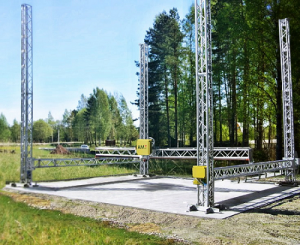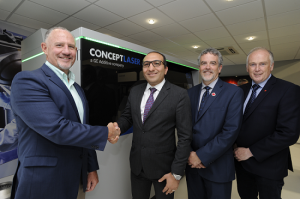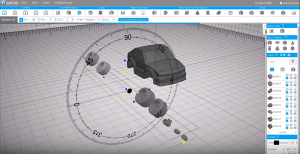We’re starting out with some construction news in today’s 3D Printing News Briefs, then following that with a little business, a little metal, and a little 3D design. Russian firm AMT-SPETSAVIA has updated two of its construction 3D printers, and the University of New Brunswick has chosen a Concept Laser 3D printer to use for its upcoming research. Mass Portal’s software team went through a reorganization, and attendees learned all about lightweight aluminum material at the recent AMAP forum. Finally, users of browser-based SelfCAD 3D software can access the MyMiniFactory design library…and share their own work there as well.
Spetsavia Completes Updates on Large Construction 3D Printers
 Three years ago, Russian firm Spetsavia presented its home construction methods and 3D printers at the 3D Print Expo. Now, the group of machining and 3D printing companies collectively known as AMT-SPECAVIA has updated its range of construction 3D printers (Construction Objects Printing or COP) to introduce two new large-format models. The S-300, with a “working field” of 11.5 x 11 x 5.4 m, is able to print directly on the foundation of buildings up to two stories and 120 square meters, while the S-500 features an 11.5 x 11 x 15 m field and can 3D print buildings up to five, or even six, floors. However, the latter can be increased to a working field of 40 x 11 x 80 m, which Spetsavia says makes it “the largest 3D construction printer in the world.”
Three years ago, Russian firm Spetsavia presented its home construction methods and 3D printers at the 3D Print Expo. Now, the group of machining and 3D printing companies collectively known as AMT-SPECAVIA has updated its range of construction 3D printers (Construction Objects Printing or COP) to introduce two new large-format models. The S-300, with a “working field” of 11.5 x 11 x 5.4 m, is able to print directly on the foundation of buildings up to two stories and 120 square meters, while the S-500 features an 11.5 x 11 x 15 m field and can 3D print buildings up to five, or even six, floors. However, the latter can be increased to a working field of 40 x 11 x 80 m, which Spetsavia says makes it “the largest 3D construction printer in the world.”
“New models of the S series are essentially the next generation of building printers. We’ve always been asked for a solution for multi-storey construction,” said Alexander Maslov, the General Director of AMT-SPETSAVIA. “Now we declare with confidence that such a solution exists! The AMT S300 and S500 printers are high-performance equipment with unprecedented capabilities and competitive price. During the development we’ve taken into account the wishes of the developing companies, at the same time maintaining the inherent reliability of our equipment, ease of management and maintenance.”
Both the S-300 and the S-500 have a direct flow print head for increased productivity, in addition to a new feed station that prepares the concrete mixture. The first shipment of the S-500 is scheduled for this fall, and a team of engineers will accompany the 3D printer to the customer for training.
University of New Brunswick to Use Concept Laser M2 Cusing

L-R: Keith Campbell, Senior Sales Director, GE Additive; Dr. Mohsen Mohammadi, Director of Research and Development for the Marine Additive Manufacturing Centre of Excellence; Hart Devitt, Director of Industry and Government Services; Duncan McSporran, Director, Programs and Innovation, Office of Research Services, University of New Brunswick
GE Additive has announced that the University of New Brunswick (UNB) in Canada, together with commercialization partner Custom Fabricators & Machinists and training partners Nova Scotia Community College (NSCC), New Brunswick Community College (NBCC), and the College communautaire du Nouveau-Brunswick (CCNB), has chosen its Concept Laser M2 Cusing metal 3D printer to use in its latest research.
UNB is in charge of the country’s first Marine Additive Manufacturing Center of Excellence, which will be the very first in Canada to fabricate certified parts for the marine industry with metal 3D printing. The M2 Cusing will mostly be used by UNB’s Dr. Mohsen Mohammadi, who will be the Director of Research and Development for the new center, and his team for multiple R&D areas, including bast resistance, enhanced corrosion protection, and hybrid 3D printing processes.
Mass Portal Announces Reorganization of Software Team
 Latvian 3D printer manufacturer Mass Portal has reorganized, and appointed new leadership for, its software team, which is now an independent company called FabControl. The company will be building an open, next-generation software platform for managing 3D printers and AM workflows, and Mass Portal’s current CEO and co-founder Janis Grinhofs, the founder of FabControl and in charge of developing Mass Portal’s flagship Pharaoh 3D printers, will now serve as the CEO of the new company. Imants Treidis has been named the new CEO of Mass Portal.
Latvian 3D printer manufacturer Mass Portal has reorganized, and appointed new leadership for, its software team, which is now an independent company called FabControl. The company will be building an open, next-generation software platform for managing 3D printers and AM workflows, and Mass Portal’s current CEO and co-founder Janis Grinhofs, the founder of FabControl and in charge of developing Mass Portal’s flagship Pharaoh 3D printers, will now serve as the CEO of the new company. Imants Treidis has been named the new CEO of Mass Portal.
“We will continue to serve our existing customers and industrial partners, in the same time striving for excellence in supplying the industry with highest quality machines and tailor built solutions for additive manufacturing needs,” Treidis said.
All About Aluminum at AMAP Forum
 Not too long ago in Aachen, scientific and industry experts gathered at the AMAP Forum (Advanced Metals and Processes) to demonstrate the continuing potential of researching non-ferrous metals, like aluminum, for the purposes of lightweight automotive design. 14 entrepreneurs from industry and five of the RWTH Aachen University institutions formed the AMAP Open Innovation Research cluster at the forum, and discussed topics ranging from new production technologies and materials development to modeling and metallurgic process technology. Some of the specifics included using aluminum hollow castings to create structural components with functional integration, additive manufacturing, and new design and calculation methods for high-strength aluminum alloys.
Not too long ago in Aachen, scientific and industry experts gathered at the AMAP Forum (Advanced Metals and Processes) to demonstrate the continuing potential of researching non-ferrous metals, like aluminum, for the purposes of lightweight automotive design. 14 entrepreneurs from industry and five of the RWTH Aachen University institutions formed the AMAP Open Innovation Research cluster at the forum, and discussed topics ranging from new production technologies and materials development to modeling and metallurgic process technology. Some of the specifics included using aluminum hollow castings to create structural components with functional integration, additive manufacturing, and new design and calculation methods for high-strength aluminum alloys.
Dr. Klaus Vieregge, Chairman of the AMAP Advisory Board and Head of the Hydro Aluminium Research and Development Center in Bonn, said, “We are an efficient network. New members are always welcome, but a high number of members is not the focus of the AMAP cluster, we want to convince people by the efficiency of the work and the research results.”
SelfCAD Partners with MyMiniFactory
 Online 3D design platform SelfCAD, founded in 2015, combines 3D modeling, slicing, and several other tools and functions in one easy program. Earlier this year, the platform announced a partnership with popular 3D printable model marketplace MyMiniFactory.
Online 3D design platform SelfCAD, founded in 2015, combines 3D modeling, slicing, and several other tools and functions in one easy program. Earlier this year, the platform announced a partnership with popular 3D printable model marketplace MyMiniFactory.
This partnership makes it easy for SelfCAD users to access the design library in MyMiniFactory, and also gives them the ability to download their 3D models directly from the marketplace while still in the SelfCAD program. In addition, it’s also possible for users to upload their models directly to MyMiniFactory for maximum exposure.
To learn more, check out this helpful video:
Discuss these stories and other 3D printing topics at 3DPrintBoard.com or share your thoughts in the Facebook comments below.
Subscribe to Our Email Newsletter
Stay up-to-date on all the latest news from the 3D printing industry and receive information and offers from third party vendors.
You May Also Like
Gorilla Sports GE’s First 3D Printed Titanium Cast
How do you help a gorilla with a broken arm? Sounds like the start of a bad joke a zookeeper might tell, but it’s an actual dilemma recently faced by...
Nylon 3D Printed Parts Made More Functional with Coatings & Colors
Parts 3D printed from polyamide (PA, Nylon) 12 using powder bed fusion (PBF) are a mainstay in the additive manufacturing (AM) industry. While post-finishing processes have improved the porosity of...
$25M to Back Sintavia’s Largest Expansion of Metal 3D Printing Capacity Since 2019
Sintavia, the digital manufacturing company specializing in mission-critical parts for strategic sectors, announced a $25 million investment to increase its production capacity, the largest expansion to its operations since 2019....
Velo3D Initiates Public Offering in a Bid to Strengthen Financial Foundations and Drive Future Growth
Velo3D (NYSE: VLD) has been among a number of publicly traded 3D printing firms that have attempted to weather the current macroeconomic climate. After posting a challenging financial report for 2023,...































